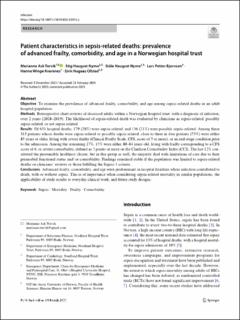| dc.description.abstract | Objective To examine the prevalence of advanced frailty, comorbidity, and age among sepsis-related deaths in an adult hospital population.
Methods Retrospective chart reviews of deceased adults within a Norwegian hospital trust, with a diagnosis of infection, over 2 years (2018–2019). The likelihood of sepsis-related death was evaluated by clinicians as sepsis-related, possibly sepsis-related, or not sepsis-related.
Results Of 633 hospital deaths, 179 (28%) were sepsis-related, and 136 (21%) were possibly sepsis-related. Among these 315 patients whose deaths were sepsis-related or possibly sepsis-related, close to three in four patients (73%) were either 85 years or older, living with severe frailty (Clinical Frailty Scale, CFS, score of 7 or more), or an end-stage condition prior to the admission. Among the remaining 27%, 15% were either 80–84 years old, living with frailty corresponding to a CFS score of 6, or severe comorbidity, defined as 5 points or more on the Charlson Comorbidity Index (CCI). The last 12% constituted the presumably healthiest cluster, but in this group as well, the majority died with limitations of care due to their premorbid functional status and/ or comorbidity. Findings remained stable if the population was limited to sepsis-related deaths on clinicians’ reviews or those fulfilling the Sepsis-3 criteria.
Conclusions Advanced frailty, comorbidity, and age were predominant in hospital fatalities where infection contributed to death, with or without sepsis. This is of importance when considering sepsis-related mortality in similar populations, the applicability of study results to everyday clinical work, and future study designs. | en_US |

